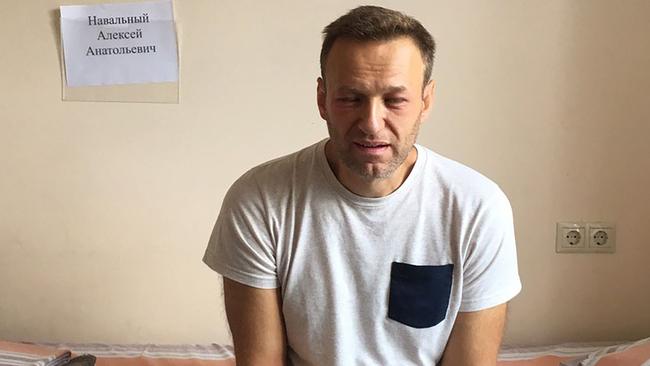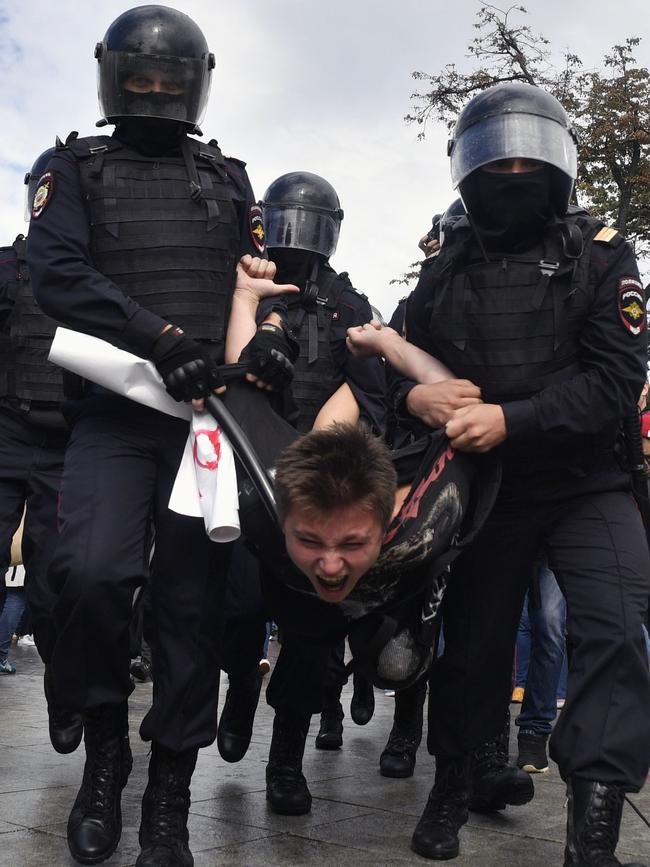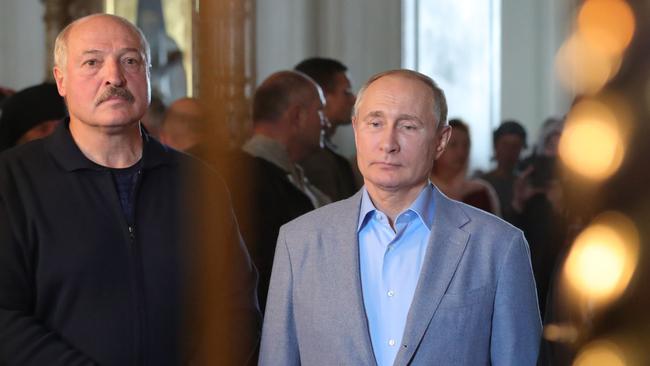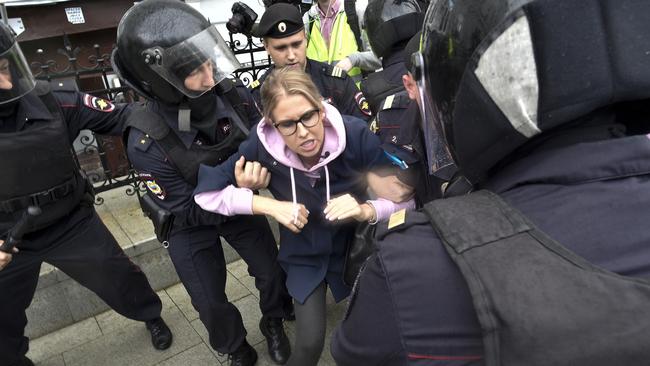Putin’s message in a poison bottle
The alleged poisoning of political activist Alexei Navalny is the latest in a long line of attacks that benefit the Kremlin.

Just as the dust was settling in Moscow after a noisy anti-government protest on July 27, Alexei Navalny, Russia’s leading opposition figure, was rushed to hospital from his prison cell.
He complained that he had been poisoned.
Navalny’s alleged poisoning coincided with a ferocious police crackdown on the opposition that continued at the weekend with the arrests of more than 800 demonstrators staging a “peaceful walk” in Moscow in protest at the barring of opposition figures from local city elections.
Chanting “Shame”, thousands of Russian opposition activists defied the ban on unauthorised demonstrations to answer Navalny’s call to join the protests. Some saw in the sudden illness of Navalny a warning that the government was prepared to play rough.
Vlad’s vendetta
Few in Russia were surprised: the number of Kremlin critics — or “treacherous spies” — who have died or fallen ill after unwittingly ingesting toxic substances, and sometimes having heart attacks, could fill a telephone directory.
Navalny, jailed for a month in the run-up to the July 27 protests, which he was accused of encouraging, has become President Vladimir Putin’s chief bugbear with well-made videos exposing mind-boggling corruption among the ruling elite.

Could Putin, a former KGB man suspected of authorising the assassination of Alexander Litvinenko — the Russian defector who suffered an agonising death in London in 2006 after drinking tea laced with radioactive polonium-210 — have wanted to kill Navalny?
Political life has proved a dangerous obstacle course for Navalny. He has been assaulted, sued and vilified as a dangerous agent of the West. His home and office have been ransacked.
When I met him in 2017 as he campaigned to run against Putin in elections — in the end, he was barred from taking part — he told me: “The question people most frequently ask me, rather annoyingly, is: why are you still alive?”
Just as in every other case of poisoning, from Sergei Skripal, the former Russian spy whose doorknob in Salisbury, England, was smeared with a nerve agent, to Vladimir Kara-Murza, who survived not one but two poisonings, the Kremlin has kept silent — with the odd exception.
Asked about the Skripal case on the eve of a meeting with then British prime minister Theresa May earlier this year, Putin reiterated his belief that “traitors must be punished” — while complaining that the Salisbury poisoning had not been worth “all the fuss”. It sounded like a tacit admission.
Poisoning leaves the government with room for plausible deniability in dealing with enemies of the state, experts say.
“One of poison’s great virtues for the politically minded murderer is the capacity to combine easy deniability and vicious theatricality,” Mark Galeotti, a senior associate fellow at the Royal United Services Institute, said last week in Foreign Policy magazine.
“Even while the murderer denies any role, perhaps with a sly wink, the victim dies a horrific and often lengthy death. A message in a poison bottle.”
Navalny not frightened
Navalny survived. Anastasia Vasilieva, his doctor, told me she saw him in hospital last Monday and is convinced his swollen eyes and the rash on his face and arms were the result of poisoning by an unknown chemical agent.
“I know his medical history. He has never suffered from allergies of any kind,” she says. “Whatever agent it was, I suppose they put it in his bed or pillow.”
The alleged attack has caused excruciating pain and put Navalny in a “dark mood”, from which he has now recovered, she adds. Rather than kill him, the poisoning, she says, is an attempt to frighten him. “But Alexei is a brave man. He is not frightened at all. It’s so stupid of them to think that they can intimidate him.”
She notes that he has been attacked once before, doused with a green dye in Siberia in 2017. It caused lasting damage to one eye but has not stopped him becoming the most constant and painful thorn in Putin’s side.

Vasilieva has sent Navalny’s T-shirt to a Russian laboratory to be tested for poison, sceptical about the authorities’ claim no traces have been found. She has every reason to be suspicious.
“If you’ve got very basic laboratory equipment, your chances of finding something are limited,” says Alastair Hay, a professor of environmental toxicology at Leeds University.
Soviet strategy
During the Cold War, the Soviet Union was known to have developed poisons as a way of taking out its enemies.
One notorious example was Georgi Markov, a Bulgarian dissident who died days after being shot with a poisonous pellet fired from the tip of an umbrella on Waterloo Bridge, London, in 1978.
Some experts believe the same research may be continuing today as Russia dispenses with troublemakers from Moscow to Salisbury, where the novichok chemical was brazenly smeared on the door of Skripal’s home. Some 1400 people were detained last weekend. Most were released but 10 face charges of fomenting mass unrest and violence, even if the protests thus far have been peaceful. They could face prison terms of up to 15 years.
Thwarting opposition
Once a low-key affair, the vote for Moscow’s city council next month has shaken up Russian politics. The Kremlin is trying to prevent any opposition figure gaining a foothold on the political ladder, even a seat on the 45-member Moscow council. Boris Yeltsin, the former president, had used this as a stepping stone to power.

Some analysts argue it is also intended to intimidate the opposition ahead of what many predict will be an attempt by Putin, who has ruled his country for almost two decades, to reshape Russia’s constitution, allowing him to stay in office indefinitely after his term expires officially in 2024. The 66-year-old President is limited to two consecutive terms, a restriction he sidestepped in 2008 by becoming prime minister temporarily before returning to the presidency in 2012. His shenanigans then prompted the biggest anti-Kremlin marches in decades.
By all accounts, he is determined to prevent a repeat, particularly as Russia’s 143 million people are growing discontented with the struggling economy: some 21 million are living below the poverty line, official statistics say.
Fear of revolt
Putin and his Kremlin associates have long lived in fear of an Arab Spring-like revolt or a “colour revolution” like the ones that did away with governments in Ukraine and Georgia.
Moscow Mayor Sergei Sobyanin called the protesters a riotous mob. “He who cries the loudest takes the power?” he said in a television interview. “We’re not in Zimbabwe, are we?”
State media claimed US and Swedish spies had stirred up unrest or that protesters had provoked police with a hail of bottles, rocks and rubbish bins.
It was even reported that one female opposition candidate, frustrated at not being able to register for the election, had got drunk and beaten her daughter.
The Sunday Times



To join the conversation, please log in. Don't have an account? Register
Join the conversation, you are commenting as Logout